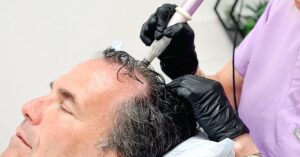CIRS: Chronic Inflammatory Response Syndrome
CIRS, or chronic inflammatory response syndrome, is a complex and progressive illness that is triggered by exposure to biotoxins such as mold. It can cause a cascade of inflammation, hormonal changes, and other symptoms in the body, and it is more common than you might think.
With a practice in Florida, I know a thing or two about biotoxin illness. Mold is everywhere. But, Florida is not the only place where mold resides. And, mold is not the only biotoxin that can make you sick. Below I will walk you through this complex and sometimes debilitating illness.
What is CIRS?
CIRS, also known as biotoxin illness, describes certain symptoms, lab findings, and targeted test results associated with biotoxin exposure. It was coined by Dr. Ritchie Shoemaker in the late 1990s to describe when a body’s immune system is not functioning properly.
There are many symptoms that can result from this illness, including: fatigue, depression, brain fog, digestive problems, headaches and other joint pain, muscle cramping, abdominal pains, blurred vision, and more (read on).
While anybody can be affected by biotoxins, genetically-susceptible people are affected most.
CIRS has an effect on the two parts of the immune system: the innate and adaptive immune responses. The innate and adaptive immune systems normally function together to remove pathogens (like biotoxins) from the body. In somebody with a normal immune response, the immune system produces antibodies to the biotoxins which bind to the biotoxins and clear them from the system.
CIRS occurs when people are exposed to certain biotoxins and their immune system does not produce antibodies against them. The biotoxins are not cleared properly and remain in the body indefinitely through a process called enterohepatic circulation. The biotoxins left in the body pass from cell to cell through cell membranes creating cell damage and causing systemic inflammation. This leads to a variety of symptoms throughout the body.
What Are Biotoxins, and How Can I Become Exposed?
Biotoxins are organic substances that can cause significant damage to your health. Biotoxins include mold and fungi, bacteria, volatile organic compounds (VOCs), endotoxins and actinomycetes.
CIRS was initially thought to be caused only by mold exposure. However, the following biotoxins can also be possible underlying causes of CIRS. The first two are the most common, but the last two are also important to mention.

Inhalation in a Water-Damaged Building
This is the most common form of exposure. A water-damaged building like your home, office, or even your car can harbor a dangerous mix of chemicals, mold, bacteria, and inflammagens that can cause illness. CIRS is not caused by one particular element, but rather the combination of these things causing multi-system inflammation in the body. Dr. Shoemaker estimates that 80 percent of CIRS cases are caused by repeated exposure to water-damaged buildings (1).

Tick or Spider Bite
Yes, even an insect bite can transmit biotoxins that can make you very sick. While you will most likely realize a brown recluse spider bite, as they can be noticeable and painful, you may not be aware that you have been bitten by a tick. Both of these bites can make you sick with biotoxin illness. Ticks can carry Lyme disease (Borrelia burgdorferi) and Babesiosis (Babesia microti), among others.

Ingestion of Poisoned Fish
Patients who have eaten reef fish contaminated with dinoflagellate algae (that produces the Ciguatera toxin) may develop an illness. Exposure to the Ciguatera toxin occurs when eating reef fish that have eaten smaller fish that consumed the toxin producing dinoflagellate.

Direct Contact with Contaminated Water
Again, this is an uncommon exposure, but worth mentioning. Patients may be exposed through direct contact with water contaminated by toxins in areas of fish kills such as Pfiesteria and Cyanobacteria, including inhalation of airborne or aerosolized toxins from this source.
How CIRS Affects the Immune System
To understand how CIRS affects the immune system, let’s review how the immune system works. Simply, there are two arms of the immune system: the innate and the adaptive.
Innate immunity
Innate immunity acts as the first line of defense against an immune threat. This is the body’s basic resistance to disease that is present from birth. It is a quick and non-specific defense mechanism.
The Innate Immune Response has two methods of defense:
- Prevention: Innate immunity can prevent the entry of a pathogen through physiological barriers like the: skin, lungs, blood brain barrier, eyes (tears), stomach (stomach acid), liver (bile acids), digestive tract (peristalsis), and the nasopharynx (saliva/lysozyme).
- Attack: If a pathogen crosses one of these physical barriers, a non-specific immune cell (like a macrophage) interacts with this pathogen to eliminate it as quickly as possible.
Adaptive Immunity
T Cells:
- Receive info from the innate immune system through specialized immune cells, called antigen-presenting cells that encounter the threat take a molecular SNIP called an epitope, and they absorb it and then present it to a T Cell.
- The T Cell is waiting to be triggered by this antigen-presenting cell.
- Once the T cell is turned on, natural killer cell activity upregulates, and then the T cell begins to trigger B cells.
B cells:
- Make antibodies. These antibodies form a more specific response to that threat, and the create memory cells in the event you are exposed to this specific pathogen again in the future.
People with chronic inflammatory response have poor antigen presentation, which means that they:
- Don’t transfer antigen information from the innate into the adaptive system.
- Not efficient in creating an antibody response.
- Stuck in the early innate immune activation, and therefore they remain sick for months and sometimes years.
How Do Genetics Play a Role?
Approximately 25% of the population have a genetic predisposition to develop CIRS. The genetic defect is located on chromosome 6 on the Human Leukocyte Antigen (HLA) system. If we think back to our lesson on the immune system above, you can remember that people with CIRS have poor antigen representation. This means that the innate immune system cannot properly identify biotoxin organisms. Thus, they do not make the antigens necessary for the hand off to their adaptive immune system where, a person without CIRS would produce antibodies to kill them.
This genetic defect can make a person susceptible to one or more biotoxin-related illnesses at once. For example, one person might be susceptible to Lyme, another person might be susceptible to mold, and a third person could be multi-susceptible to many biotoxin-related illnesses (1).
What Are the Symptoms Associated with CIRS?
CIRS can affect every bodily system, causing many possible symptoms including. Some common symptoms are:
- Cognitive difficulties such as brain fog and trouble concentrating
- Fatigue and weakness or chronic fatigue syndrome
- Unexplained weight gain
- Frequent urination, excessive thirst, dehydration
- Fibromyalgia
- Visual insensitivity
- Post nasal drip and sore throat
- Numbness and tingling
- Digestive issues
- Mood swings
- Tinnitus
- Static shocks
- Vertigo
- Metallic taste in mouth
However, there are many symptoms that can be associated with CIRS. While the symptoms can seem random, Dr. Shoemaker’s statistical analysis revealed that CIRS symptoms can actually be grouped together in specific clusters.
Common Misdiagnoses
Due to the lack of awareness in the conventional medical community, the complexity of CIRS can be confused with other conditions and illnesses. Common misdiagnoses include:
- Chronic Fatigue Syndrome
- Fibromyalgia
- Depression and Anxiety
- Allergies
- Hypochondria
- Attention Deficit Disorder (ADD/ADHD)
- Irritable Bowel Syndrome (IBS)
- Post-traumatic Stress Disorder (PTSD)
Diagnosing CIRS
Diagnosing CIRS can be just as complex as the illness itself, but generally, a complete medical history and exam documenting all of the signs and symptoms consistent with biotoxin exposure is completed.
Another useful tool to help with diagnosis is a Visual Contrast Sensitivity (VCS) test. This test measures a person’s ability to detect visual patterns. Biotoxins cause neurological symptoms which include diminished ability to detect certain visual patterns. This test is highly accurate and sensitive for biotoxin exposure.
However, we also use the following laboratory tests to make a CIRS diagnosis:
- Mycotoxin testing – These tests can identify biotoxins in your blood created by mold.
- Human Leukocyte Antigen (HLA) genetic test
- MARCoNS – Multiple Antibiotic Resistant Coagulase Negative Staphylococci (MARCoNS) live inside the nasal cavity. These can contribute to CIRS and need to be identified and treated.
- Mold CIRS Panel of laboratory markers. This panel tests for MMP9, TGF-beta1, MSH, ADH, and osmolality.
- Vasoactive Intestinal Polypeptide (VIP)
- Melanocyte Stimulating Hormone (MSH)
- Transforming Growth Factor Beta–1 (TGF Beta-1) – Normal range is <2380 pg/ml.
- C4a
- Antigliadin (AGA IgA/IgG)
- Adrenocorticotropic hormone (ACTH)/Cortisol
- Vascular Endothelial Growth Factor (VEGF)
- Antidiuretic hormone (ADH)/Osmolality
- Matrix Metallopeptidase 9 (MMP-9)
- Leptin
Get tested today: 561-283-1166
Natural Methods to Improve CIRS
🚧 Identify and Remove the Source
The first step to improving CIRS is to identify and address the biotoxin that is triggering this response. Like I said above, for some people, there may be more than one biotoxin source that needs to be addressed.
💊 Support Your Detoxification Pathways
Optimizing your detoxification pathways is important for everybody. Making sure that your liver, kidneys, and digestive systems are working to purge environmental toxins from our bodies is pivotal for vibrant wellness. However, if you have been exposed to mold or other biotoxins, detoxing is an excellent way to keep your body working to remove them from your body. Read my Mold Detox article here.
🌬 Use an Air Filter/Purifier
We always like to keep you informed about the products we love, but a powerful air purifier is always at the top of our list. We love the iAdaptAir® HEPA Purifier, which we think is one of the best and smartest home air purifiers out there.
💧 💩 Stay Hydrated!
Good hydration is key when you are trying to eliminate biotoxins. Optimal hydration also helps keep your bowels moving. You want to try and eliminate the biotoxins in your body as frequently as possible: that’s 1-4 times a day! Drinking half of your weight in water everyday is a good method to keep your system moving.
🔥 Saunas, Dry Brushing, and more!
Saunas, manual dry brushing of your body, and even a little morning sunlight can help keep your body detoxing biotoxins.
Targeted Supplements for CIRS:
There are many supplements that can be very helpful in both detoxing biotoxins from the body and also helping with the myriad symptoms that CIRS can induce. While a personalized approach with your physician is always the best route, I will list two of my most used supplements when it comes to CIRS.

Candikill
CandiKill is formulated to target Candida albicans and other fungal infections (like mold). Candida infections can produce various symptoms depending on the area of infection.*

Micro Gone Tincture
MicroGone Tincture is a unique herbal tincture designed to help fight infections of the gastrointestinal tract.*

GI Detox
One of the most important supplements for improving CIRS is a charcoal binder to remove the biotoxins like mold from your body.*

MycoPul
MycoPul® employs multiple targeted binders to remove mycotoxins (toxins produced by mold), from the GI tract. Because each mycotoxin is unique and responds differently, MycoPul’s proprietary MycoPlex™ blend is formulated with multiple targeted ingredients shown in research to bind the most prevalent mycotoxins.*
Vibrant Spore IG
Gut infections go hand in hand with CIRS. A spore-based probiotics helps to regulate dysbiosis and designed to relieve small intestinal bacterial overgrowth (SIBO) (read my article on SIBO here). Our Vibrant Spore IG is my absolute favorite probiotic for just about anybody.*
Are You Suffering From CIRS?
Do these symptoms sound familiar to you? Does your home, office, or car smell musty/mildewy? Have you been diagnosed with chronic fatigue or anxiety, and you feel like there is something else causing these symptoms? You could potentially be suffering from this complex disease. CIRS is complex and chronic, and it can have a debilitating effect on your quality of life. But there is hope! There are many ways to approach biotoxin illness from a natural and functional perspective.
Leave your questions and comments below, and I will answer them as soon as possible.
If you’re interested in learning more about CIRS or biotoxin testing, you can always book a consult at Tringali Vibrant Health. Our providers can help.
In VIBRANT Health,
Elizabeth Tringali, PA-C
561-283-1166










